Floating primrose-willow identification and control
Information about the noxious weed floating primrose-willow. Floating primrose-willow is also known by its scientific name, Ludwigia peploides.
About this weed
Floating primrose-willow is a regulated Class A noxious weed. This means eradication is required state-wide.
It is also on the Washington quarantine list, and it is illegal to buy, sell, or offer it for sale in the state.
Floating primrose-willow is known as Ludwigia peploides and is in the evening primrose/willowherb family, Onagraceae. Another common name is creeping water primrose.
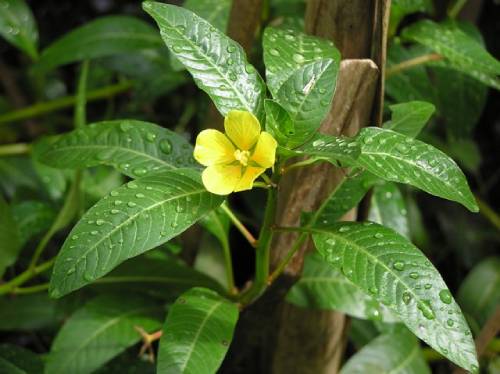
Why it's a noxious weed
-
Floating primrose-willow can create dense floating mats that clog waterways and reduce habitat quality.
-
Dense growth of the plant can impede boat navigation, clog irrigation canals, increase sedimentation and reduce water flow.
-
It is not eaten by animals and can displace native vegetation used by waterfowl and other wildlife.
-
It is fast-growing. In France, a small patch of 400 square feet grew to cover 320 acres in five years.
-
When established, it can change water chemistry (reduce pH and dissolved oxygen) and harm fish habitat.
Plant description
-
Leaves grow alternately on the plant stem (not opposite), are up to 9 cm long and egg to lance shaped.
-
Leaves have smooth edges (margins) and taper to a stalk that is 2.5 to 4 cm long.
-
Showy yellow flowers with five petals bloom from late July into August.
-
Stems of the plant tend to float along the water surface or grow flat along the mud.
-
Stems are fleshy, reddish, and up to 2 meters long.
-
Plants spread through plant fragmentation (Easily lost parts that have high potential to grow into a complete plant).
Floating primrose-willow is native to Australia, New Zealand, and parts of North America and South America.
Floating primrose-willow grows in freshwater wetlands, ponds, shorelines and streams. The plant can tolerate depths up to 10 feet and can also grow up onto land and can tolerate dry spells. In Washington state, the one known infestation is in a ponded area along a tributary to the Cedar River in King County.
Floating primrose-willow has been introduced to and is invasive in France, Belgium, Italy, Netherlands, Australia and in the United States in Delaware, New York, Oregon and Washington state.
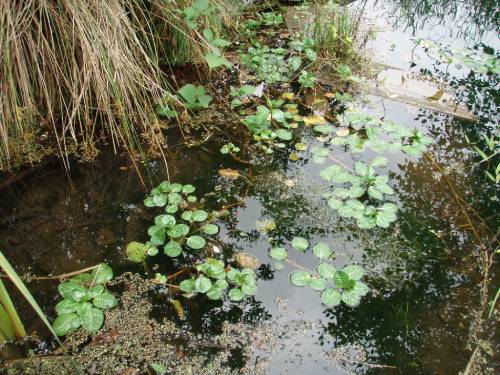
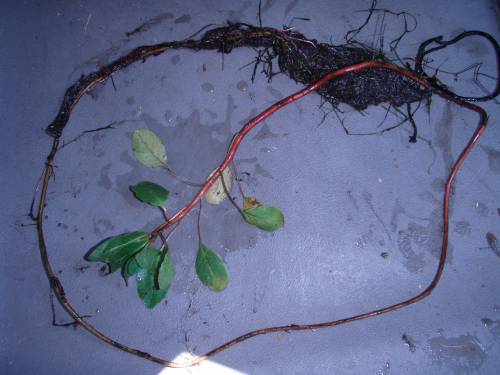
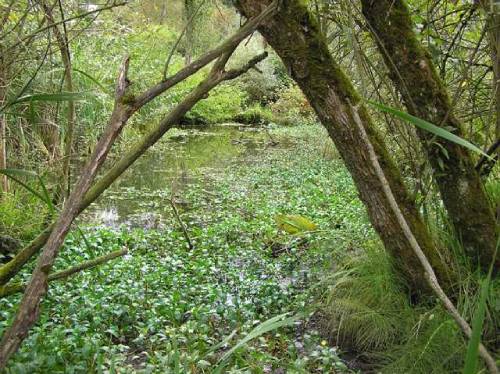
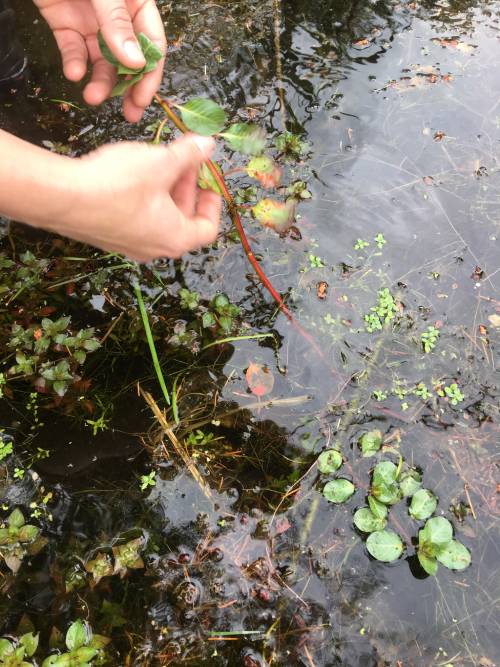
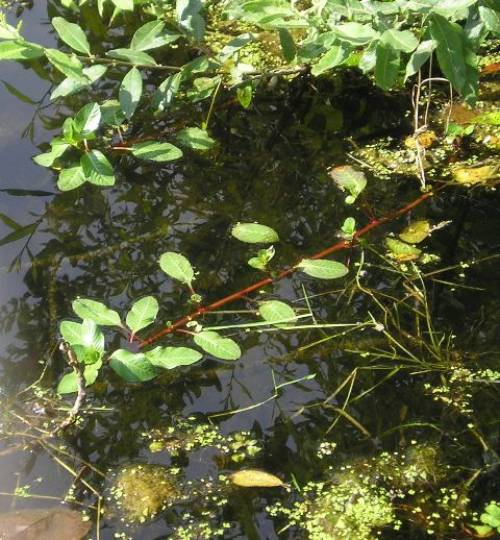
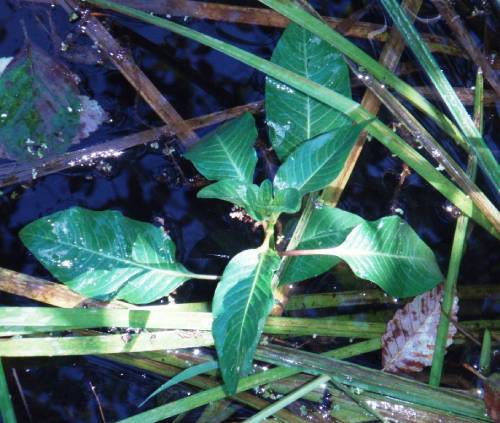
Be aware of look-alike plants
Floating primrose-willow may be confused with:
Class B noxious weed: water primrose (Ludwigia hexapetala), is closely related and looks similar to water primrose with yellow flowers and alternate growing leaves. But the look-alike tends to have more upright flowering stems and leaves are longer (to 15 cm), more dull/less waxy, and narrower and more pointed. Both of these plants are high priority noxious weeds.
Native plant: water purslane (Ludwigia palustris), is closely related but easier to distinguish than the above species. The native plant has flowers, but they are not obvious. They are sessile (no flower stalk) and lack petals. Their small unnoticeable green flowers sprout from between the stem and leaves. Leaves, unlike those of L. peploides or L. hexapetala, grow opposite (nose-to-nose) along the stem.
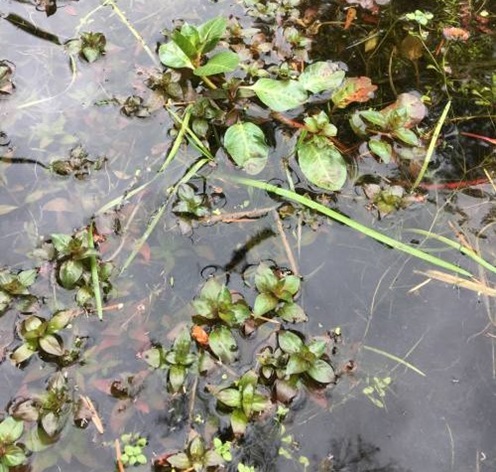
Floating primrose-willow in upper right/center and the native water purslane (Ludwigia palustris) in bottom left/center. Leaves of water primrose (not pictured) are longer and narrower than both of these.
When in doubt, take photos and share them with us or report them on iNaturalist.
What to do if you find it
Property owners are required to control floating primrose-willow on lands that they manage. Please notify us if you see floating primrose-willow growing in King County. Our program staff can provide the property owner or appropriate public agency with site-specific advice on how best to remove it. We map all known locations of regulated noxious weeds such as floating primrose-willow in order to help us and others locate new infestations in time to control them.
This plant is often distributed through movement of watercrafts and water related equipment. Make sure you inspect your watercraft at the boat launch before entry and after exit to avoid spreading any invasive or nuisance aquatic plants or animals. See King County’s boating information web page for more information.
Control methods
We recommend using a combination of methods to control noxious weeds. In areas with few weeds, it is important to act quickly before they become harder to control. Make a long-term plan as it often takes several years to get rid of most weeds. Start in the least infested areas first and then move into more heavily infested areas. Floating primrose-willow plants are very difficult to control. Incomplete control methods such as cutting can lead to further spread of viable plant fragments. These plant fragments can re-grow and increase the infestation. The entire plants must be removed for control to be effective.
Prevention
Floating primrose-willow may be sold as a water plant so be sure to check the scientific name of all plants before purchasing them, especially through the internet where companies may not be aware of Washington state laws. If you do spot this plant growing in a new place, be sure to act quickly to remove it entirely to keep it from spreading.
Manual control
Aquatic plant control that does not involve herbicide often requires a (free) permit. The rules and regulations for this type of removal will depend on your circumstance, please visit the WA Dept Fish and Wildlife for access to their Aquatic Plants & Fish Pamphlet and guidance on how to use it properly.
Digging can be effective with small infestations. Be sure to remove the entire plant and not leave any stem or root fragments behind. Dispose of plants in the garbage to avoid spreading the plant further.
Chemical control
Controlling this species is very challenging once it is established in a waterway. Herbicides that are registered for aquatic use in Washington have shown some effectiveness although multiple years of application are needed for complete control.
Stay safe when using herbicide:
- Always read the label before use.
- Wear a long-sleeved shirt, long pants, shoes, and eye protection.
- Follow state and local regulations.
Avoid spraying where there is a chance that herbicide will enter a waterway or wetland unless you are using a state-approved aquatic herbicide and have the required permits and licenses to do so. Use of pesticides in water is regulated in Washington state. See Washington Department of Ecology Aquatic Pesticide Permits for details.
For more information or a site-specific recommendation in King County, contact the noxious weed program. For information in other locations, contact your local weed board or extension office.
For information in other counties in Washington state, contact your local weed board or your local cooperative extension office.
Disposal instructions
To prevent further spreading or resprouting, plant material from regulated weeds such as floating primrose-willow, should be disposed of in the garbage.
Noxious Weed Disposal - Washington State Noxious Weed Control Board

 Translate
Translate